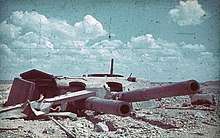Maxim Gorky Fortresses
Maxim Gorky I and Maxim Gorky II (Russian designation: Coast Batteries #30 and #35) were coastal batteries used by the Soviet Union in the Crimea during World War II in the Crimean Campaign. The invading German forces during the Second World War gave the batteries their English name: Maxim Gorky (a famous Soviet author and political activist). These are not their Russian names.
Maxim Gorky I

Maxim Gorky I (Russian: Бронебашенная батарея-30, romanized: Armored Coastal Battery-30) was located east of Ljabimorka, at 44.664°N 33.559°E (north of Severnaya Bay which formed Sevastopol's harbor), and contained two twin gun turrets[1] which could fire four 30.5 cm guns.[2] Once the Germans had broken through the Perekop Isthmus in October 1941, they advanced on Sevastopol but were confronted by Maxim Gorky I. They deployed the 80cm rail gun Schwerer Gustav to destroy it. On June 6, 1942, heavy guns and Karl-Gerät siege mortars managed to make direct hits on the battery which destroyed one of the gun turrets and damaged the other.[3] None of these were successful in eliminating the Maxim Gorky I, however, and it was not until June 17 that it was put out of action by German assault engineers.[4] According to the Soviets, the batteries guns ran out of ammunition, firing was forced to cease, and the fortification was subsequently blown up by the crew.[5]
Maxim Gorky II
Maxim Gorky II (Russian: Бронебашенная батарея-35, romanized: Armored Coastal Battery-35), which was armed with similar battleship turrets to Maxim Gorky I, was located on seaward cliffs on the southwest side of Sevastopol (44.559°N 33.407°E.[6] On July 4, Maxim Gorky II was taken after the Sapun positions were captured, making it the last major pre-war fortification to take part in a campaign.[7]
Preservation

The 35th Battery (Maxim Gorky II) was repaired and made into a museum complex commemorating the sacrifice of its defenders. Funding was acquired via charity, primarily from Aleksei Chaly, a Russian businessman who declared himself mayor of Sevastopol shortly before the 2014 Crimean status referendum.
Footnotes
- "...the first with twin gun turrets located east of Ljabimorka (north of the bay)..." Kuafmann, J. E. Fortress Europe: European fortifications of World War II Da Capo Press, p. 365.
- "...to the four giant 30.5 cm guns of the Maxim Gorky I coastal battery..." Weal, John. Ju 87 Stukageschwader of the Russian Front. Osprey Publishing, p. 34.
- "After the Germans overran the Perekop Line...the Germans deployed their super heavy artilley, including the 80cm rail gun Dora to destroy key points like Maxim Gorky I. On June 6, heavy German guns and mortars fired on Maxim Gorky I and scored direct hits that destroyed one of the turrets and damaged the other." Kuafmann, J. E. Fortress Europe: European fortifications of World War II Da Capo Press, p. 369.
- "Additional artillery fire and air bombardment failed to eliminate the Maxim Gorky damaged turret, which was finally put out of action by assault engineers on June 17."Kuafmann, J. E. Fortress Europe: European fortifications of World War II Da Capo Press, p. 369.
- "The Soviet version is that Coastal Battery 30 - its official designation - ceased firing simply because it had run out of ammunition, and was blown up by its crews." Weal, John. Ju 87 Stukageschwader of the Russian Front. Osprey Publishing, p. 36.
- "...the second with a set of similar turrets situated on the southwestern end of the peninsula where Sevastopol stood." Kuafmann, J. E. Fortress Europe: European fortifications of World War II Da Capo Press, p. 365.
- On July 4, after taking the Sapun positions, and the final assault that took Maxim Gorky II, the campaign against the last major pre-war fortified position came to a close." Kuafmann, J. E. Fortress Europe: European fortifications of World War II Da Capo Press, p. 369.